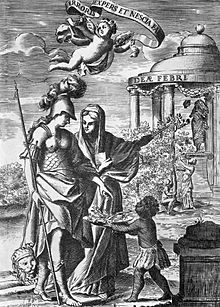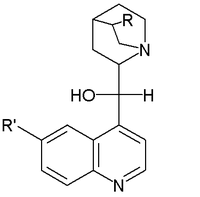- Cinchona
-
For other uses, see Cinchona (disambiguation).
Cinchona 
Cinchona pubescens - flowers Scientific classification Kingdom: Plantae (unranked): Angiosperms (unranked): Eudicots (unranked): Asterids Order: Gentianales Family: Rubiaceae Subfamily: Cinchonoideae Tribe: Cinchoneae[1] Genus: Cinchona
L.Species about 38 species; see text
Cinchona or Quina is a genus of about 38 species in the family Rubiaceae, native to tropical South America.[2] They are large shrubs or small trees growing 5–15 metres in height with evergreen foliage. The leaves are opposite, rounded to lanceolate and 10–40 cm long. The flowers are white, pink or red, produced in terminal panicles. The fruit is a small capsule containing numerous seeds.
The bark of the tree is medicinally active containing a variety of alkaloids, including the anti-malarial compound quinine which interferes with the reproduction of malaria-causing protozoa, and quinidine, an antiarrhythmic.The bark is stripped from the tree, dried, and powdered for medicinal use. As a medicinal herb, cinchona bark is also known as Jesuit's bark or Peruvian bark. The plants are cultivated in their native South America, and were transported for cultivation in other tropical regions notably India Sri Lanka by the British and Java by the Dutch in nineteenth century.[3]
The name of the genus is due to Carolus "Carl" Linnaeus, who named the tree in 1742 after a Countess of Chinchón, the wife of a viceroy of Peru, who, in 1638, was introduced by natives to the medicinal properties of the bark. Stories of the medicinal properties of this bark, however, are perhaps noted in journals as far back as the 1560s–1570s (see the Ortiz link below)[where?]. Cinchona species are used as food plants by the larvae of some Lepidoptera species including The Engrailed, The Commander, and members of the genus Endoclita including E. damor, E. purpurescens and E. sericeus.
Contents
History
Main article: Jesuit's barkThe Italian botanist Pietro Castelli wrote a pamphlet noteworthy as being the first Italian publication that mentions the cinchona. By the 1630s (or 1640s, depending on the reference), the bark was being exported to Europe. In the late 1640s, the method of use of the bark was noted in the Schedula Romana, and in 1677 the use of the bark was noted in the London Pharmacopoeia.
According to legend, the first European ever to be cured from malaria fever was the wife of the Spanish Viceroy of Peru, the countess of Chinchón. Chinchón is a small town in central Spain. The court physician was summoned and urged to save the countess from the waves of fever and chill that were threatening her life, but every effort failed to relieve her. At last the physician administered some medicine which he had obtained from the local Indians, who had been using it for similar syndromes. The countess survived the malarial attack and reportedly brought the cinchona bark back with her when she returned to Europe in the 1640s.
In 1753 Carolus Linnaeus named the bark Cinchona after the countess of Chinchón. The story of the cure of the countess, however, is doubtful.
Charles II called upon Mr Robert Talbor, who had become famous for his miraculous malaria cure. Because at that time the bark was in religious controversy, Talbor gave the king the bitter bark decoction in great secrecy. The treatment gave the king complete relief from the malaria fever. In return, he was offered membership of the prestigious Royal College of Physicians.
In 1679 Talbor was called by the King of France, Louis XIV, whose son was suffering from malaria fever. After a successful treatment, Talbor was rewarded by the king with 3,000 gold crowns. At the same time he was given a lifetime pension for this prescription. Talbor, however, was asked to keep the entire episode secret.
After Talbor's death, the French king found this formula: six drams of rose leaves, two ounces of lemon juice and a strong decoction of the cinchona bark served with wine. Wine was used because some alkaloids of the cinchona bark are not soluble in water, but are soluble in [the ethanol in] wine.
The birth of homeopathy was based on cinchona bark testing. The founder of homeopathy, Dr. Samuel Hahnemann, when translating the Cullen's Materia medica, noticed that Dr. Cullen wrote that Peruvian bark was known to cure intermittent fevers. [4] Dr. Hahnemann took daily a large, rather than homeopathic, dose of Peruvian bark. After two weeks, he said he felt malaria-like symptoms. This idea of "like cures like" was the starting point of his writings on "Homeopathy". Hahnemann's symptoms are believed to be the result of a hypersensitivity to Cinchona bark on his part.[5]
In 1738, Sur l'arbre du quinquina, a paper written by Charles Marie de La Condamine, a member of the expedition that was sent to Peru to determine the length of a degree of the meridian arc in the neighbourhood of the equator, was published by the French Academy of Sciences. In it he identified three separate species.[6]
In 1742, on the basis of a specimen received from La Condamine, Linnaeus named the tree Quinquina condaminiae and established a new genus, which he termed Cinchona quinquina condaminiae. In 1753 he described Cinchona officinalis as a separate species.[7]
Cultivation
The bark was very valuable to Europeans in expanding their access to and exploitation of resources in far off colonies, and at home. Bark gathering was often environmentally destructive, destroying huge expanses of trees for their bark, with difficult conditions for low wages that did not allow the indigenous bark gatherers to settle debts even upon death.[8]
Further exploration of the Amazon valley and the economy of trade in various species of the bark in 18th century is captured by the extract from a book by Lardner Gibbon:
"...this bark was first gathered in quantities in 1849, though known for many years. The best quality is not quite equal to that of Yungas, but only second to it. There are four other classes of inferior bark, for some of which the bank pays fifteen dollars per quintal. The best, by law, is worth fifty-four dollars. The freight to Arica is seventeen dollars the mule load of three quintals. Six thousand quintals of bark have already been gathered from Yuracares. The bank was established in the year 1851. Mr. [Thaddäus] Haenke mentioned the existence of cinchona bark on his visit to Yuracares in 1796."(Source: Exploration of the Valley of the Amazon, by Lieut. Lardner Gibbon, USN. Vol.II, Ch.6, pp. 146-47.)
In 1860, a British expedition to South America led by Clements Markham brought back Cinchona seeds and plants, which were introduced in several areas in India and Sri Lanka. In Sri Lanka, it was planted in the Hakgala Botanical Garden in January 1861.[9] James Taylor, the pioneer of tea planting in Sri Lanka, was one of the pioneers of Cinchona cultivation.[10] By 1883 about 64,000 acres (260 km2) were in cultivation in Sri Lanka, with exports reaching a peak of 15 million pounds in 1886.
In 1865, "New Virginia" and "Carlota Colony" were established in Mexico by Matthew Fontaine Maury. American post-war confederates were enticed there by internationally famous and former confederate, Matthew Fontaine Maury, the Imperial Commissioner of Immigration through Emperor Maximillian, Archduke of Habsburg. All that survives today of those two colonies are the flourishing groves of cinchonas, the quinine-producing trees purchased by Matthew Fontaine Maury using seeds purchased from England. These seeds were the first to be introduced into Mexico. (Sources: "Life of Maury" by Diane Corbin and "Scientist of the Sea" by Frances Leigh Williams.)
Chemistry
Cinchona alkaloids
The bark of trees in this genus is the source of a variety of alkaloids, the most familiar of which is quinine, an anti-fever agent especially useful in treating malaria. Cinchona alkaloids include:
- cinchonine and cinchonidine (stereoisomers with R = vinyl, R' = hydrogen)
- quinine and quinidine (stereoisomers with R = vinyl, R' = methoxy)
- dihydroquinidine & dihydroquinine (stereoisomers with R = ethyl, R' = methoxy)
They find use in organic chemistry as organocatalysts in asymmetric synthesis.
Other chemicals
Alongside the alkaloids, many cinchona barks contain cinchotannic acid, a particular tannin, which by oxidation rapidly yields a dark-coloured phlobaphene[11] called red cinchonic,[12] cinchono-fulvic acid or cinchona red.[13]
Species
- Cinchona antioquiae L.Andersson (1998).
- Cinchona asperifolia Wedd. (1848).
- Cinchona barbacoensis H.Karst. (1860).
- Cinchona × boliviana Wedd. (1848).
- Cinchona calisaya Wedd. (1848).
- Cinchona capuli L.Andersson (1994).
- Cinchona fruticosa L.Andersson (1998).
- Cinchona glandulifera Ruiz & Pav. (1802).
- Cinchona hirsuta Ruiz & Pav. (1799).
- Cinchona krauseana L.Andersson (1998).
- Cinchona lancifolia Mutis (1793).
- Cinchona ledgeriana
- Cinchona lucumifolia Pav. ex Lindl. (1838).
- Cinchona macrocalyx Pav. ex DC. (1829).
- Cinchona micrantha Ruiz & Pav. (1799).
- Cinchona mutisii Lamb. (1821).
- Cinchona nitida Ruiz & Pav. (1799).
- Cinchona officinalis L. (1753): Quinine Bark
- Cinchona parabolica Pav. in J.E.Howard (1859).
- Cinchona pitayensis (Wedd.) Wedd. (1849).
- Cinchona pubescens Vahl (1790) : Quinine Tree
- Cinchona pyrifolia L.Andersson (1998).
- Cinchona rugosa Pav. in J.E.Howard (1859).
- Cinchona scrobiculata Humb. & Bonpl. (1808).
- Cinchona villosa Pav. ex Lindl. (1838).
- Cinchona succirubra
- Cinchona robusta
- Cinchona hybrida
Notes
- ^ "Genus Cinchona". Taxonomy. UniProt. http://www.uniprot.org/taxonomy/43462. Retrieved 2010-02-13.
- ^ Motley, Cheryl. "Cinchona and its product--Quinine". Ethnobotanical leaflets. Southern Illinois University Herbarium. http://www.ethnoleaflets.com/leaflets/quinine.htm. Retrieved 11 June 2010.
- ^ Rice, Benjamin Lewis (1897). Mysore: A gazetteer compiled for Government Vol. 1. Westminister: A Constable. pp. 892. http://www.archive.org/stream/mysoregazetteerc01rice#page/n199/mode/2up/search/cinchona+biligiri.
- ^ William Cullen, Benjamin Smith Barton (1812). Professor Cullen's treatise of the materia medica. Edward Parker. http://books.google.co.uk/books?ei=n2wXTo7gBcqp8APc7KAi&ct=result&sqi=2&output=text&id=GMIwAAAAYAAJ&dq=cullens+materia+medica&ots=SKQIG8rn2T&q=cinchona#v=snippet&q=peruvian&f=false.
- ^ William E. Thomas. "Chapter 2: The basis of Homeopathy". Homeopathy; Historical Origins and the End.
- ^ Joseph P. Remington, Horatio C. Wood, ed (1918). "Cinchona". The Dispensatory of the United States of America. http://www.henriettesherbal.com/eclectic/usdisp/cinchona.html.
- ^ Charles M. Poser, G. W. Bruyn (1999). An illustrated history of malaria. Parthenon Pub. Group. ISBN 1850700680. http://books.google.com/books?id=N4fyLSwLP3MC&pg=PA91&lpg=PA91&dq=cinchona+la+condamine&source=web&ots=8U1k8mspB_&sig=5DiEd8TFi7fqpn1ianLWroDgtXA#PPA91,M1.
- ^ Taussig, M. (1987). Shamanism, Colonialism and the Wild Man. University of Chicago Press.
- ^ "Hakgala garden". Department of Agriculture, Governent of Sri Lanka. http://www.agridept.gov.lk/institutes_sub_more.php?id=123&mMenu=Botanic%20Gardens&sMenu=National%20Botanic%20Gardens%20%28NBG%20%29. Retrieved 11 June 2010.
- ^ Fry, Carolyn (6 January 2007). "The Kew Gardens of Sri Lanka". Travel (London: Timesonline, UK). http://www.timesonline.co.uk/tol/travel/article1289534.ece. Retrieved 11 June 2010.
- ^ Henry G. Greenish (1920). "Cinchona Bark (Cortex Cinchonae). Part 3". A Text Book Of Materia Medica, Being An Account Of The More Important Crude Drugs Of Vegetable And Animal Origin. J. & A. Churchill. ASIN B000J31E44. http://chestofbooks.com/health/materia-medica-drugs/Textbook-Materia-Medica/Cinchona-Bark-Cortex-Cinchonae-Part-3.html.
- ^ Alfred Baring Garrod (2007). "Cinchonaceae. Part 2". Essentials Of Materia Medica And Therapeutics. Kessinger Publishing. ISBN 1432688375. http://chestofbooks.com/health/materia-medica-drugs/The-Essentials-Therapeutics/Cinchonaceae-Part-2.html.
- ^ "Quinine". Encyclopaedia Britannica (10 ed.). 1902. http://www.1902encyclopedia.com/Q/QUI/quinine.html.
References
- Reader's Digest, Strange Stories, Amazing Facts II; Title : "The Bark of Barks" -Reader's digest publication
- The Journals of Hipólito Ruiz: Spanish Botanist in Peru and Chile 1777-1788, translated by Richard Evans Schultes and María José Nemry von Thenen de Jaramillo-Arango, Timber Press, 1998
- Druilhe, P., et al.. "Activity of a combination of three Cinchona bark alkaloids against Plasmodium falciparum in vitro". Antimicrobial Agents and Chemotherapy 32 (2): 25-254.
External links
Wikimedia Foundation. 2010.





